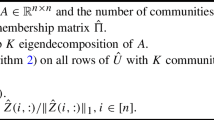Abstract
Identification and classification of overlapping nodes in networks are important topics in data mining. In this paper, a network-based (graph-based) semi-supervised learning method is proposed. It is based on competition and cooperation among walking particles in a network to uncover overlapping nodes by generating continuous-valued outputs (soft labels), corresponding to the levels of membership from the nodes to each of the communities. Moreover, the proposed method can be applied to detect overlapping data items in a data set of general form, such as a vector-based data set, once it is transformed to a network. Usually, label propagation involves risks of error amplification. In order to avoid this problem, the proposed method offers a mechanism to identify outliers among the labeled data items, and consequently prevents error propagation from such outliers. Computer simulations carried out for synthetic and real-world data sets provide a numeric quantification of the performance of the method.








Similar content being viewed by others
Explore related subjects
Discover the latest articles, news and stories from top researchers in related subjects.References
Belkin M, Matveeva I, Niyogi P (2004) Regularization and semisupervised learning on large graphs. In: Conference on learning theory. Springer, Berlin, pp 624–638
Belkin M, Niyogi P, Sindhwani V (2005) On manifold regularization. In: Proceedings of the tenth international workshop on artificial intelligence and statistics (AISTAT 2005). Society for Artificial Intelligence and Statistics, New Jersey, pp 17–24
Blum A, Chawla S (2001) Learning from labeled and unlabeled data using graph mincuts. In: Proceedings of the eighteenth international conference on machine learning. Morgan Kaufmann, San Francisco, pp 19–26
Breve FA, Zhao L, Quiles MG (2009) Uncovering overlap community structure in complex networks using particle competition. In: International conference on artificial intelligence and computational intelligence (AICI’09), vol 5855, pp 619–628
Breve FA, Zhao L, Quiles MG, Pedrycz W, Liu J (2012) Particle competition and cooperation in networks for semi-supervised learning. IEEE Trans Knowl Data Eng 24:1686–1698. doi:10.1109/TKDE.2011.119. http://doi.ieeecomputersociety.org/10.1109/TKDE.2011.119
Chapelle O, Schölkopf B, Zien A (eds) (2006) Semi-supervised learning. In: Adaptive computation and machine learning. The MIT Press, Cambridge
Danon L, Díaz-Guilera A, Duch J, Arenas A (2005) Comparing community structure identification. J Stat Mech Theory Exp 9:P09,008
Duch J, Arenas A (2005) Community detection in complex networks using extremal optimization. Phys Rev E Stat Phys Plasmas Fluids 72:027,104
Duin R, Juszczak P, Paclik P, Pekalska E, de Ridder D, Tax D, Verzakov S (2007) Prtools4.1, a matlab toolbox for pattern recognition
Fortunato S (2010) Community detection in graphs. Physics Reports 486(3-5):75–174. doi:10.1016/j.physrep.2009.11.002
Frank A, Asuncion A (2010) UCI machine learning repository. http://archive.ics.uci.edu/ml
Joachims T (2003) Transductive learning via spectral graph partitioning. In: Proceedings of international conference on machine learning. AAAI Press, Menlo Park, pp 290–297
Karypis G, Han EH, Kumar V (1999) Chameleon: hierarchical clustering using dynamic modeling. IEEE Comput Archit Lett 32(8):68–75
Lancichinetti A, Fortunato S (2009a) Benchmarks for testing community detection algorithms on directed and weighted graphs with overlapping communities. Phys Rev E 80:016,118, doi:10.1103/PhysRevE.80.016118. http://link.aps.org/doi/10.1103/PhysRevE.80.016118
Lancichinetti A, Fortunato S (2009b) Community detection algorithms: a comparative analysis. Phys Rev E 80:056,117, doi:10.1103/PhysRevE.80.056117. http://link.aps.org/doi/10.1103/PhysRevE.80.056117
Lancichinetti A, Fortunato S, KertTsz J (2009) Detecting the overlapping and hierarchical community structure in complex networks. New J Phys 11(3):033,015. http://stacks.iop.org/1367-2630/11/i=3/a=033015
Newman M (2006) Modularity and community structure in networks. Proc Natl Acad Sci USA 103:8577–8582
Newman MEJ, Girvan M (2004) Finding and evaluating community structure in networks. Phys Rev E Stat Phys Plasmas Fluids 69:026,113
Palla G, Derényi I, Farkas I, Vicsek T (2005) Uncovering the overlapping community structure of complex networks in nature and society. Nature 435(7043):814–818. doi:http://dx.doi.org/10.1038/nature03607
Quiles MG, Zhao L, Alonso RL, Romero RAF (2008) Particle competition for complex network community detection. Chaos 18(3):033,107. doi:10.1063/1.2956982
Reichardt J, Bornholdt S (2004) Detecting fuzzy community structures in complex networks with a potts model. Phys Rev Lett 93(21):218,701
Zachary WW (1977) An information flow model for conflict and fission in small groups. J Anthropol Res 33:452–473
Zhang S, Wang RS, Zhang XS (2007a) Identification of overlapping community structure in complex networks using fuzzy c-means clustering. Phys A Stat Mech Appl 374:483–490. doi:10.1016/j.physa.2006.07.023
Zhang S, Wang RS, Zhang XS (2007b) Uncovering fuzzy community structure in complex networks. Phys Rev E 76(4):046103. doi:10.1103/PhysRevE.76.046103
Zhou D, Bousquet O, Lal TN, Weston J, Schölkopf B (2004) Learning with local and global consistency. In: Advances in Neural Information Processing Systems, vol 16. MIT Press, Cambridge, pp 321–328
Zhu X (2005) Semi-supervised learning literature survey. Tech. Rep. 1530, Computer Sciences, University of Wisconsin-Madison
Zhu X, Ghahramani Z, Lafferty J (2003) Semi-supervised learning using gaussian fields and harmonic functions. In: Proceedings of the twentieth international conference on machine learning, pp 912–919
Acknowledgments
This work was supported by the São Paulo State Research Foundation (FAPESP), the Brazilian National Research Council (CNPq), and the Foundation for the Development of Unesp (Fundunesp).
Author information
Authors and Affiliations
Corresponding author
Rights and permissions
About this article
Cite this article
Breve, F., Zhao, L. Fuzzy community structure detection by particle competition and cooperation. Soft Comput 17, 659–673 (2013). https://doi.org/10.1007/s00500-012-0924-3
Published:
Issue Date:
DOI: https://doi.org/10.1007/s00500-012-0924-3




